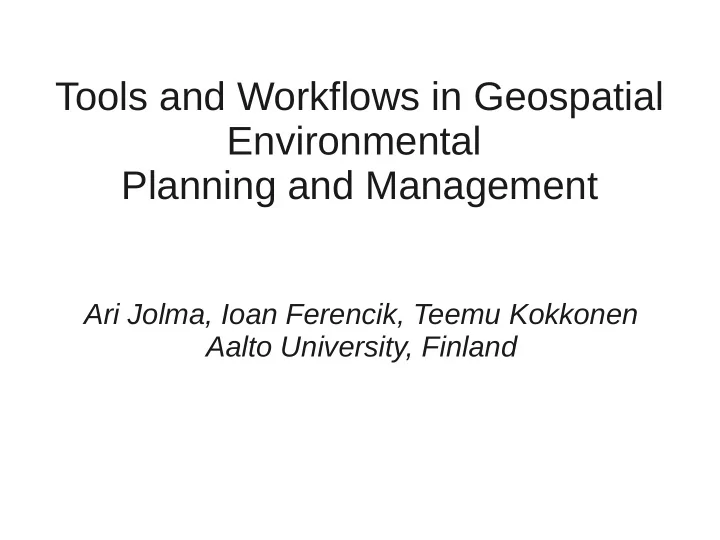

Tools and Workflows in Geospatial Environmental Planning and Management Ari Jolma, Ioan Ferencik, Teemu Kokkonen Aalto University, Finland
Contents ● An apology ● Context ● Environmental modeling ● Workflows for environmental modeling and management ● Case studies ● Conclusions
Context ● iEMSs (International Environmental Modelling and Software Society) wishes to advance (among other things) ● automated but informed use of models, and ● integrated modeling ● OGC manages a consensus process to develop publicly available geospatial standards ● iEMSs and OGC have signed a MoU ● OGC presented a Workshop on Model Interoperability for the Web at the iEMSs Biennial Congress in Ottawa, Canada, July this year
Technological context ● Development of services and (interface) standards for communicating ● Data ● Processing ● Models ● Knowledge in the Internet
Environmental modeling ● Tools for ... ● examining components of and their interactions in ● predicting outcomes of ● revealing implications of assumptions in ● enhancing communication among interest groups of ● ... ● … natural resources management ● Construction ► Testing ► Use
Environmental models, categories ● Simulation models (dynamic simulation of state in time) ● Optimization models (the “best” set of parameters, or structure for a plan) ● Statistical models (e.g. random variables representing a state arranged in a structure) ● Decision models (or methods that aid decision making) ● ... ● Several other categorizations have been presented.
Benefits to be expected ● Ready availability of data as standard services ● Data feeds from sensors and sensor networks ● Baseline data ● Improved meta data of (increasing trust in) models ● Statements of assumptions ● Reports of testing the whole model ● Instructions how to use the model ● Discussion of problems and issues ● Improved collaboration and communication possibilities
Foreseen problem areas ● Lack of comprehensive definition of “an environmental model” ● Matching the temporal and spatial scale and other characteristics of available data to the requirements of the model ● Problems in how to systematically represent knowledge incorporated in models ● Lack of tools for supporting high level workflows required by model construction, testing and use
Workflow of building of an environmental model ● (Jakeman et al.(2006) Ten iterative steps...) ● Purpose ►Context ►Conceptualization ►Prior information ►Features ►Parameterization method ►Performance criteria ►Parameterization ►Verification ►Quantification of uncertainty ►Evaluation ● Useful/required services include – Knowledge (also of the workflow itself) – Data (catalogs, browsing also to aid conceptualization) – Processing services (parameter estimation, model verification) – Documentation and meta data (upload)
Integrated assessment and modeling (IAM) ● Coupling (integrated use) of models representing different components of natural and social systems ● Coupling (integrated use) of models representing processes at different spatial scales ● Tools for generating scenarios ● Stakeholder participation ● Setting objectives ● Designing management strategies ● Setting preferences ● Implementing plans ● Decision support ● Typical workflow: intelligence ► design ► choice ► action
Benefits and problems regarding IAM ● Distributed control of information assets ● A stated goal of IAM is to adapt the model to the case with an IA process ● Can we improve the model validation? ● Communication ● Technical difficulties in setting up services ● No or very little work on analyzing and supporting formally workflows
Case studies ● On-site environmental modeling and management ● Topic of an ongoing FP7 research project HYDROSYS ● Hydrological / environmental hydraulics models ● Assessment of risks and pollution; management options ● Oil spill combating ● Assessment of environmental values ● Support for combating operations
Experience/conclusions so far ● Web data integration is sometimes (often?) seen as “plumbing”, i.e., little or interest in conceptualization or data modeling ● The GSN software ● Environmental model is much more than a processing service ● We've been working on exposing a environmental hydraulics model as a WPS ● Stakeholders have no experience yet in asking for services of this kind
Thank You! Ari Jolma ari.jolma@tkk.fi
Recommend
More recommend